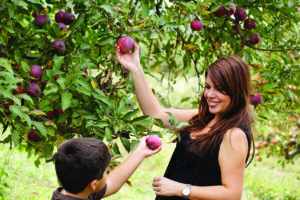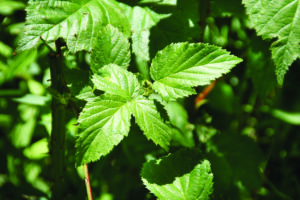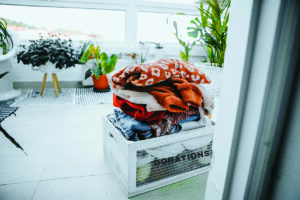How-to Guide
Learn How-to . . .
. . . Avoid the Buildup of Clutter
. . . Clean Your Grill
. . . Get the Most Out of Apple Picking
. . . Grill a Juicier Burger
. . . Make a Yard Less Attractive to Ticks
. . . Pair Beer with Food like a Pro
. . . Pick Paint for Home Interiors
. . . Safely Wipe Out an Old Computer
. . . Save Your Lawn During Watering Restrictions
. . . Take Steps to a More Functional Kitchen
. . . Upgrade Bathroom Safety Features
. . . Watch Out for These Poisonous Backyard Plants


How-to Get the Most Out of Apple Picking
Apple picking is a beloved autumn tradition. While many traditions had to be put on the back burner as the world dealt with the COVID-19 pandemic, apple picking seems like one activity that can endure in a world dominated by social distancing.
Apple picking season tends to begin in mid- to late-September and ends sometime in early October. That makes apple picking a perfect social distancing activity, as it’s both outdoors and at a time of year when the weather is generally pleasant no matter where you live.
Individuals interested in apple picking this fall can take heed of these tips to ensure their trip is fun, safe and successful.
· Contact the farm in advance. Apple picking is a wildly popular activity, so expect a crowd to be there on a typical autumn weekend. That can be tricky to navigate while social distancing, so call ahead to learn about new protocols and if the operating hours are the same. If the farm is open several days per week, ask which days are the least busy and schedule your trip when foot traffic figures to be minimal.
· Choose firm apples without bruises. According to Pickyourown.org, apples should be crisp and firm. Don’t worry about the color of the apple, as color is not an indicator of ripeness. Instead, Pickyourown.org advises people to ask the farmers which apples are ripe, which is determined by how long it’s been since the trees flowered.
· Gently place picked apples into your basket. Pickyourown.org recommends gently placing apples into your basket after picking them. Tossing them into the basket may cause bruising, which can lead to the apples spoiling prematurely. While it depends on the variety, many apples that are not bruised tend to last a long time, especially when stored in a cool place. So taking care of them when picking them can mean you get to enjoy apples for several weeks.
· Clean apples before eating them. The Food and Drug Administration notes that produce can be contaminated even after it’s been picked and brought home. The FDA advises consumers to wash their hands for 20 seconds with warm water and soap before and after preparing fresh produce. Produce should be rinsed before it’s peeled so any lingering dirt and bacteria are not transferred from the knife onto the fruit or vegetable. If bruising has occurred, cut away the damaged or bruised areas before preparing or eating it.
Apple picking is a beloved autumn tradition that can be even more fun when employing a few strategies designed to make it more safe and fruitful.

How-to Upgrade Bathroom Safety Features
Bathrooms can benefit from updates that improve their form and function. While styles and color patterns may inspire bathroom renovations, improvements to safety also should be considered.
Bathrooms can be one of the most dangerous rooms in a house. Bath and shower areas account for about two-thirds of accidental injuries in these spaces. Many other injuries involve the toilet. In 2008, a thorough investigation of bathroom dangers conducted by the Centers for Disease Control and Prevention found that mishaps near the bathtub, shower, toilet, and sink caused an estimated 234,094 nonfatal injuries in the United States among people aged 15 years and older.
Seniors are particularly vulnerable in the bathroom due to reduced mobility and flexibility, visual impairment and other factors. However, some key modifications can make bathrooms much safer for aging populations.
· Raised toilet seat: Install an ADA-compliant raised toilet seat. Standard toilet seats are roughly 15 inches high, but elevated seats can raise the bowl an additional two to four inches. Another option is to invest in risers that can be attached to an existing toilet.
· Grab bars: Seniors may use towel holders as grab bars, which don’t have stability and can dislodge from the wall. Install secured side grip bars by the toilet and inside the shower to make maneuvering easier.
· Water temperature: Seniors may be vulnerable to hot water temperatures. Lower the water temperature setting on the hot water heater. StaySafe.org recommends 120 F.
· Faucets: Change faucet handles to paddle-style handles rather than knobs. Knobs can be challenging to grip for those with arthritis in their hands. Also, handles that are easier for seniors to use can reduce the risk of the elderly losing their balance as they attempt to gain leverage to turn the water on and off.
· Nonslip mats: Nonslip mats or tape strips can be used in showers and tub bottoms, as well as outside of the shower to reduce the risk of slips and falls. Rugs should have rubberized, slip-resistant backing.
· Rounded corners: Choose counters and fixtures with rounded corners. Should a senior fall against something, the rounded corner may prevent serious injury.
· Shower benches and transfer seats: Benches and transfer seats make it easier getting in and out of the shower. Also, sitting while showering reduces the risk of becoming light-headed or losing balance.
· Walk-in tubs/showers: Minimizing the threshold to the shower or bathtub is an important safety feature. Some manufacturers make walk-in tubs with doors that secure and make watertight seals. Showers that don’t have a lip or tub to scale also are better for seniors.
· Lighting: Eyesight weakens over time, so improve lighting with combinations of overhead lighting and softer side lighting. Night lights or soft-glowing toilet lights can make it easier to get around the bathroom in the middle of the night.
These are just some improvements that can create safer bathroom environments for seniors.

How-to Pick Paint for Home Interiors
Many components combine to define a home’s interior. Some homeowners may be partial to certain styles, such as ultra modern or farmhouse, while others may opt for a more traditional look that cannot necessarily be categorized as one style or another. Though many homeowners may spend considerable time and devote a lot of energy to making their home embody a certain style, those who aren’t willing to commit to a particular look can lean on one component to make a stylish statement all their own: paint.
Color can be a part of every homeowner’s design arsenal. Bold colors can be used to create a stunning accent wall, while homes with open concepts often utilize color to define rooms. Homeowners who want to revitalize their home interiors can do so with paint, and this approach doesn’t require homeowners to commit to a whole new design style.
Though paint may seem simple to novices, homeowners who have painted home interiors in the past recognize how complicated the process of picking paint can be. Paint retailers have a seemingly endless swatch of paint colors to choose from, and before long homeowners heads may be spinning as they try to narrow down their options. The following tips can help homeowners pick the perfect paint for their home interiors.
· Take stock, and photographs, of your current furnishings. Many interior designers rely on a simple technique when recommending color schemes to their clients. Choose a standout color from existing furnishings, such as the dominant color from a patterned decorative pillow or piece of furniture, and then look for the same shade to paint the walls. A photograph of the item can be handy when visiting the paint store.
· Lighten colors as you go up. The home renovation and design experts at HGTV recommend picking darker color values for the floor, medium color values for the walls and light values for the ceiling. This approach mimics the look of the great outdoors, where the ground tends to be darker than the trees, and the trees are darker than the blue sky.
· Utilize paint to create the vibe you want. The home renovation experts at This Old House note that colors evoke an emotional response. Cool colors like blue and green give off a relaxing vibe, which makes them ideal for bedrooms and bathrooms. Red is an intense color that can up the energy ante in any room, which can make it an option for homeowners who want to spark debate around their dinner tables.
· Give personal preference its place at the table. Though interior designers may have years of experience picking paint colors for a home and researchers may have determined how certain colors can be utilized to create a desired ambiance in a given room, ultimately homeowners are the ones who will be living in the home. So it’s important that homeowners pick colors they like for their home interiors.
Paint is an inexpensive way to transform a room. Homeowners can rely on a combination of color strategies and their personal preferences as they try to decide which colors they want on their interior walls.



How-to Grill a Juicier Burger
Summer weekends wouldn’t be the same without backyard barbecues. And no backyard barbecue is complete without hamburgers.
The exact origins of the hamburger are unknown, but historians believe this beloved staple of American barbecues can be traced to mid-nineteenth century Germany. According to History.com, political revolutions in Germany in the 1840s spurred many Germans to emigrate to the United States. Germans brought many of their cultural traditions with them, including their cuisine. One such dish was the chopped steak, which can be traced to Hamburg, a city renowned for its high-quality beef. Though few might now see ground beef as a remedy for digestive issues, that was a common belief in the 1860s, when a New York-based doctor named James Salisbury suggested that cooked beef patties could benefit the digestive system as much as chopped, chipped or ground beef. Buns were not yet in the picture at that time, but they were by 1904, when beef patties on buns were available at the St. Louis World’s Fair. In 1921, the first White Castle restaurant opened in Kansas, and hamburgers have been a staple of American cuisine ever since.
Though it’s been a century since White Castle opened its first restaurant, people are still perfecting the art of making the perfect hamburger. Exactly what defines the perfect hamburger may be open to debate, but there’s no denying the desirability of juicy burgers. As grillmasters prepare for another season of backyard barbecues, the following are some ways they can make their burgers more juicy.
· Avoid extra-lean meat. Extra-lean meat might be healthier than the alternatives, but 93 percent lean ground beef is unlikely to produce juicy burgers. When making burgers from scratch, opt for 80 percent lean. WebMD notes that fat helps to hold burgers together while searing and cooking the meat. The result is a more juicy interior than cooks are likely to get when using lean meats.
· Swap beef for lamb. Cookbook author John Holl notes in his book, “The American Craft Beer Cookbook” (Storey), that substituting ground beef with ground lamb makes for a juicier burger. Lamb is moist, so unlike lean beef, it can be grilled as well-done without drying out. Lamb also offers a different taste than beef, adding a little variety to a backyard barbecue.
· Saddle your spatula. Flipping the burgers too much or pressing them against the grill as they cook can dry them out.
· Be conscious of carryover cooking time. Carryover cooking time refers to the length of time temperature in a food continues to rise even after it’s been removed from a cooking area. Beef is among the many foods that continue to cook after being removed from a heat source, so beef burgers can be removed from the grill before they reach the desired cooking temperature. This prevents drying out and ensures that once they’re served, the burgers will be juicy and safe to eat.
Grilling a juicy burger is easily accomplished with a few simple and time-tested strategies.


How-to Watch Out for These Poisonous Backyard Plants
Spending time in the backyard can be restorative and relaxing. Is it any wonder why homeowners are increasingly improving their homes so that they can blur the lines between the indoors and outside and enjoy more recreational moments in nature?
Part of what makes a landscape inviting is the bevy of plants dotting suburban landscapes. Individuals may take painstaking pleasure in mapping out landscapes that are both functional and appealing. When selecting foliage, it’s wise for homeowners to familiarize themselves with certain plants that may not be very welcome in their entertaining areas – particularly those that are dangerous. Poison ivy, oak and sumac may be some of the better-known poisonous plants, but there are others that can prove problematic as well.
· Hogweed: This is an invasive plant that grows throughout North America but is particularly well-known along the Atlantic coast. The sap in the leaves can cause phytophotodermatitis, which is a chemical reaction after exposure to sunlight. Painful, severe blisters can form on the skin wherever it touches, and hogweed sap may cause blindness if it gets into the eyes.
· Lily of the Valley: This plant is known for delicate, bell-shaped flowers and a sweet scent. While Lily of the Valley is not poisonous to touch, if ingested, toxic glycosides in the flowers, berries, leaves, and stems may cause a host of problems, including disorientation, vomiting, blurry vision, and rashes.
· Bleeding Heart: Native to woodlands, this perennial loves the shade. It produces unique flowers that resemble tiny pink or white hearts with drops of blood at the bottom. Roots and foliage of Bleeding Heart contain alkaloids that are toxic to animals if ingested in high quantities.
· Nerrium Oleander: All parts of this beautiful shrub are extremely poisonous. It should definitely be kept away from pets and treated with caution or avoided altogether.
· Foxgloves: Adored among pollinators, Foxgloves produce towering pink and white trumpet blooms in early summer. The whole plant is toxic if eaten, however. People who eat any part or attempt to make tea may find their heart rate slowing down or becoming irregular.
· Stinging Nettle: Brushing up against Stinging Nettle can be a painful experience. The plant has tiny stinging hairs on its leaves and stems.
· Wild Hemlock: This is a very poisonous member of the carrot family. If consumed, Wild Hemlock, which looks like parsley, can cause health problems. Toxins also can be absorbed through the skin.
· Deadly Nightshade (Belladonna): A beautiful plant that produces shiny, black cherry-like berries, this contains a poison that can paralyze the gastrointestinal muscles and eventually the heart. The Royal Horticultural Society says that even rubbing up against it can irritate the skin.
Many plants, however beautiful, can be dangerous if ingested or touched.


How-to Take Steps to a More Functional Kitchen
A kitchen is often the most utilized room in a house. Meals may be prepared, cooked and often eaten in kitchens, and the room is often utilized as a homework spot or a makeshift place to pay bills and stay on top of household needs. By enhancing the organization and functionality of the kitchen, homeowners can enjoy these popular spaces even more.
Homeowners have increased their spending on home improvements in recent years. According to the Joint Center for Housing Centers for Harvard University, project spending rose to $472 billion in 2022 from $328 billion in 2019. It’s estimated consumers will have spent $485 billion by the end of 2023. Kitchen renovations were the most popular upgrade and accounted for the highest budgets in 2021, according to Houzz. When the time comes to renovate a kitchen, homeowners can take steps to make these spaces more organized and therefore functional. Here are eight tips to creating a more functional kitchen.
1. Increase storage, and then invest in more. Make the most of corner cabinets and other potential dead spots in a kitchen. Various products can be used to organize awkwardly angled or shaped areas. Kitchen designers also can work with you to reconfigure cabinets and kitchen layouts.
2. Organize utensils and dishes around the sink/dishwasher. Rather than traversing the kitchen to put clean dishes away, make loading and unloading the dishwasher that much easier by locating commonly used items next to and above it. Similarly, place frequently used saucepans, baking dishes and other items near the oven or food preparation area.
3. Utilize drawer and cabinet organizers. Make a place for everything in the kitchen. Take out all items and see what you need and use all the time. Then coordinate storage around those items so everything fits perfectly. Pull-out shelves and Lazy Susans also can facilitate access.
4. Add shelves to cabinets. If you can afford to have a custom-built kitchen, by all means design cabinets according to preference. If you’re using standard cabinets, you may have to reconfigure shelves and spacing to fit the items you have. This also will help you maximize cabinet space.
5. Organize the garbage. Have a pull-out drawer or cabinet to store trash bins. Separate compost, trash and recycling needs.
6. Create continuity in the room. Many open concept homes will have kitchens open up to another room in the home. Mirror the design scheme from elsewhere in the house, and make sure that the flow between spaces is not obstructed.
7. Create a beverage station. A beverage station can minimize the time needed to make a cup of tea or coffee or for the kids to grab juice or chocolate milk.
8. Have a workspace in the kitchen. Whether paying bills, making a grocery list or leaving notes for the family, a dedicated workspace can add more function to the room. Be sure there is task lighting nearby and ample overhead lighting to ensure that all kitchen needs are illuminated properly.
A more functional kitchen can make this already popular space even more so.

How-to Make a Yard Less Attractive to Ticks
Backyards are ideal places to spend warm afternoons soaking up some sun. Lazy days in the yard are a big part of what makes warm weather seasons like spring and summer so appealing. But those afternoons can quickly go off the rails when an unwelcome visitor makes its presence known.
Ticks can be found throughout the world, but the Centers for Disease Control and Prevention notes that only a select few types of ticks transmit bacteria, viruses and parasites, or pathogens, that cause diseases in people. But even if the number of tick species that transmit diseases to humans is relatively low, ticks that can infect humans are a notable threat. Such ticks carry pathogens that the CDC notes can cause a number of diseases, including Bourbon virus, Ehrlichiosis and, of course, Lyme disease, among others.
Human beings can come into contact with ticks in their own backyards. But humans can take various steps to make their lawns less welcoming to ticks.
· Cut your grass short and keep it that way. Black-legged ticks are transmitters of Lyme disease, which the CDC notes is the most common vector-borne disease in the United States. Lyme disease also poses a growing threat in Canada, where data from the Public Health Agency indicates human-reported Lyme disease cases increased fromm 144 in 2009 to more than 2,100 in 2022. Black-legged ticks do not like environments that are dry and hot, so short grass makes lawns less attractive to this type of tick. Consumer Reports advises homeowners who have let their grass grow a little too high (around five or six inches) to bag their clippings when cutting the grass. Lots of clippings on the grass can provide a respite from the heat for black-legged ticks.
· Create a tick barrier if your property abuts woods. Woods provide a cover from summer heat that black-legged ticks crave. So properties that abut the woods may be more vulnerable to these unwanted guests than yards that do not border woodlands. A barrier of dry mulch made of wood chips between a property and a bordering wooded area can help repel ticks, who won’t want to settle in often dry, hot mulch beds.
· Plant with infestation prevention in mind. Some plants can help to repel ticks because they boast certain characteristics that ticks cannot tolerate. The fragrances, textures and oils of plants like garlic, mint, lavender, marigolds, and others create less welcoming conditions for ticks. Homeowners can speak with local garden centers for advice on tick-repellant plants that can thrive in their particular climate and on their properties.
· Remove yard debris. Piles of wood, leaves and brush can make for good conditions for ticks that transmit disease. After raking leaves and gathering brush, discard the resulting piles immediately.
These measures will not necessarily prevent all ticks from establishing themselves on a property, so individuals are urged to inspect their bodies and the bodies of their pets after a day in the yard.



How-to Clean Your Grill
Millions of people across the globe have a passion for grilling. Cooking over an open flame imparts a unique flavor to a variety of foods, and that profile can be augmented with marinades, wood chips and a host of other tweaks that help to create a delicious finished product.
Though many people grill throughout the year, this particular method of cooking is most popular in summer, when welcoming temperatures compel cooks to prepare meals outdoors. As grilling season kicks into high gear, grillmasters can embrace these strategies to ensure their grills remain clean.
· Clean after each use. Once food is cooked, cooks’ minds immediately shift to eating. But cleaning a grill immediately after each use can make it easier to remove all the debris that can gather as foods cook. Fat, grease, melted cheese, marinades, and other substances can accumulate on the grill over time. Though grillmasters can eat before cleaning their grills, keep the fire going until after eating (vents can be slightly closed to reduce the heat somewhat), then scrape food and other debris off the grill. Grates that are still warm are easier to clean, but use heat-proof grilling gloves when cleaning warm or hot grates to reduce burn risk.
· Oil the grates before cooking. A light coating of oil brushed onto the grill grates prior to cooking can reduce the likelihood that food sticks to the grill while it’s being cooked. Food stuck to a grill can be difficult to remove, but the oil can reduce the likelihood that ground beef from burgers or chicken breasts will stick to the cooking surface.
· Deep clean the grill every so often. Grill grates may not need a deep clean after each use, particularly when only preparing food for a handful of people. However, a deep cleaning every so often, and after heavy usage during backyard barbecues, can remove debris that can accumulate and pose a health risk over time. Follow the grill manufacturer’s instructions regarding cleaning the grill. Some might suggest traditional dish soap like Palmolive is safe to use, while others might recommend particular soaps that can protect the long-term life of the grill. Cast-iron grill grates generally should not air dry, so dry these parts off immediately after cleaning.
· Use the right tools. Steel grill brushes are popular, but these cleaning tools can be unsafe. Steel brush bristles can break off during vigorous cleaning sessions, and they may get stuck on the grill during the cleaning process. If stuck on the grill, steel bristles can easily attach to food. The cooking experts at Epicurious note that steel brush bristles can cause throat and/or abdominal issues if consumed. Alternatives to steel bristle grill brushes are widely available, but grillmasters should know that some, including nylon brushes, should not be applied to a grill until its grates have cooled off.
· Clean all components. Grease traps, ash pans and the interior of the grill, including its sides and the inside of lids, can be periodically cleaned to reduce grease buildup and the risk of exposure to germs.
Grilling is a wildly popular summer pastime. Ensuring grills are clean prior to cooking can make foods more flavorful and decrease the risk of illness.


How-to Save Your Lawn During Watering Restrictions
Has this scenario happened to you? You toil throughout the early spring seeding and fertilizing your lawn and start to reap the benefits of this hard work when the thick, green grass fills in. Your curb appeal peaks and your landscape is picture-perfect.
Enter the harsh weather of summer and a long stretch of little to no rain. With reservoirs showing depleting water levels, drought restrictions are issued in your neighborhood, and you are mandated to greatly reduce water usage and perhaps even cease watering the lawn. Is this the end of that great, green carpet of grass?
On the surface it may seem like keeping a lawn healthy during watering restrictions is a losing battle. After all, grass needs water to thrive. However, there are some things homeowners can do to prolong the life of their lawns until restrictions are lifted.
Mow less often
Tall grass can shade the soil and its delicate roots, helping to avoid even further evaporation of what precious water the lawn is getting. Space out mowing to every other week or even every two weeks, particularly if you notice the grass is growing more slowly due to less watering. Mowing stresses a lawn, and the grass is already stressed from lack of water. Mowing less frequently can help.
Water early on
Maximize the benefits of any irrigation system by watering during the early morning hours, or between 2 and 9 a.m. This is when wind speeds are usually lower and evaporation from wind and sun is less likely to occur. Keep in mind that watering restrictions may specify which hours and days you are allowed to water.
Change your grass
Certain species of grass are more resilient in drought conditions. According to Scotts, Bermuda, Zoysia, St. Augustine, Bahia, and Buffalo grasses are more drought-tolerant than others in southern climates. Drought-resistant grasses for northern climates include Tall Fescue and Kentucky Bluegrass. You may consider switching to one of these types if drought and water restrictions in your area have become more common in recent years.
Utilize grass clippings
Lack of water can contribute to higher soil temperatures, which affects soil organic matter, says The Grass Outlet. Grass clippings left on the lawn can reduce soil temperature, increase infiltration of water into the soil, and improve the lawn’s ability to store water. Be sure to evenly distribute the clippings so they don’t clump and choke the grass.
Consider an amendment
Hydretain is a soil moisture manager that its producer attests can extend watering intervals for grass, trees, shrubs, and plants by as much as two to three times. It also is supposed to minimize drought stress and help lower water usage, and thus avoid watering restriction fines. The product’s hygroscopic and humectant components attach to plant root hairs, drawing moisture vapor from the soil and turning that vapor into droplets.
A proactive approach can help individuals protect their lawns when water restrictions are in place.


How-to Pair Beer with Food like a Pro
Even though pizza, wings and beer is a combination that has appeared on game day food tables seemingly since the dawn of organized sports, the nuances of beer open up the possibility for many other food-beverage combinations. Just as wine can complement a variety of different foods when the right combination of flavors is presented, so, too, can one’s favorite brew.
Craft brewers have opened the public’s eyes to a much wider array of beer styles than may be available at the local liquor store or supermarket. Below you can find some suggestions for beer and food pairings, courtesy of the Brewers Association.
· Blonde Ale: Match this ale with lighter food choices, such as chicken, salads, and light, nutty cheeses.
· India Pale Ale: The hoppy forward flavor of IPAs makes these popular beers a good pairing with strong, spicy foods, or bold, sweet desserts.
· Amber/Red Ale: Pair a wide range of foods with amber ales, like chicken, seafood, burgers, and spicy cuisine.
· Porter: The strong flavor of porter will work well with roasted or smoked food, barbecue, sausages, or blackened fish.
· Dark Lager, Dunkel, Schwarzbier: Hearty, spicy foods, barbecue, and roasted meats also complement these dark beers, as do pizzas and burgers.
· Hefeweizen: Fans of this light German or Austrian beer will learn it pairs well with salads, seafood, sushi, and traditionally weisswurst, a white Bavarian sausage.
· Imperial Stout: This beer can easily overwhelm many foods, but can stand up to foie gras or smoked goose. Long-aged cheeses, like gouda, parmesan or cheddar, also can work with stout, as do rich, chocolate desserts.
· American Wheat Ale: Choose this beer to go with very light foods like salads and sushi. It’s generally too light for dessert, but might work with fresh fruit.
Furthermore, when pairing beer with food, keep in mind that beer with hop bitterness, roasted malt, high carbonation, and higher ABVs balance sweet, rich (fatty) and umami flavors in food. Hop bitterness also can emphasize the spice of foods, such as in chili or certain ethnic cuisines. A sweet or malty beer balances out spiciness or acidity in foods.


How-to Avoid the Buildup of Clutter
Clutter has a way of taking over a home. As time goes by, items that are not stored or discarded when they’ve lost their utility can gradually take over a space, creating a claustrophobic, cluttered feeling that can affect how people feel in their homes.
Clutter is not something to be taken lightly. A 2010 study published in the journal Personality and Social Psychology Bulletin found that women who characterized their living spaces as cluttered or marked by unfinished projects were more likely to experience fatigue and depression than women who described their homes as restful and restorative. Though clutter is often discussed in terms of removing it, there’s also many ways to prevent it in the first place.
· Schedule weekly cleaning sessions. Cleaning is a chore few look forward to, and that reluctance may be a byproduct of infrequent cleanings. The less a home is cleaned, the longer cleaning sessions take when individuals get around to it. Weekly cleaning sessions can help prevent items from stockpiling and creating a cluttered look.
· Discard items when they’re no longer used. Holding on to items you no longer use will eventually contribute to the buildup of clutter. That’s a lesson parents know well, as kids outgrow toys, which can then pile up and contribute to overcrowded toy chests and play rooms. Adults also have a hard time discarding their own toys, including old devices. As kids outgrow toys, let them choose which ones to discard before they’re replaced with new items. The same goes for adults, who can wipe old devices like tablets, smartphones and laptops clean and discard them once they’ve purchased replacements.
· Make it easy to find stored items. Even the most well-organized person can fall victim to clutter if stored items prove difficult to find. When revamping storage systems, choose clear, stackable drawers so you won’t make a mess as you look for stored items you can’t find. Clear, stackable plastic bins and drawers make it easier to find what you’re looking for, reducing the likelihood that items will end up on the floor or strewn about. If you don’t want to replace existing storage bins, label them if they’re not clear to make it easier to identify what’s inside.
· Donate clothing. Much like kids’ toys and adults devices should be discarded when they’re no longer used, old clothes can be donated to create more storage space and prevent the buildup of clutter. Clutter is often described as something visible to the naked eye, but clutter can also build up in dresser drawers and behind closet doors. Periodically go through closets and dressers and remove items you no longer wear, donating them if they’re still in good shape and discarding them if they’re not.
Clutter can quickly take over a home. A proactive approach that emphasizes clutter prevention can make for a more relaxing and restful home.

How-to Safely Wipe Out an Old Computer
The idea of losing all personal data on a computer, phone or tablet may send a person into a panic. How many times has a drive failed or a computer crashed and a person has worried that all of their essential files were lost forever? But there are times when it could be essential to clear data from a hard drive. That includes before selling the device, discarding it or giving it away.
NordVPN® says someone can access sensitive information many think is gone forever after deletion, but actually could still be stored in the hard drive. Short of removing the hard drive, which would necessitate a new owner putting in a new hard drive, devices will have to be wiped clean to ensure sensitive information is not vulnerable. Devices can be wiped completely when they are changing hands. Consumer Reports says this is done by performing a “factory reset.” This technically wipes the drive clean of personal data.
Before initiating a factory reset, it’s important to back up any important data onto the cloud or an external hard drive. Depending on the operating system, hard drive type and device, the instructions for wiping a hard drive will vary. It’s best to do a search online or ask a technology expert about the most expeditious way to restore factory settings. Even still, there are some issues when wiping a drive that may prove problematic.
If a person recently purchased a computer, it likely has a solid-state drive. SSDs are faster and more stable than older, mechanical hard drives and use flash memory. That means securely deleting files is very hard. This is why Wirecutter suggests encrypting the drive, which uses a mathematical process to mix up the data using a key that only the device owner has. Without the key, files on the drive will look like gibberish if someone successfully recovers them. Encrypting an SSD computer is recommended even if one has no intention of selling or trading it later. Chromebooks usually use SSD but Google enables encryption by default. Chromebook users can skip this step when resetting. Again, encryption varies based on the OS, so it’s best to study the right way to do so.
Files do not automatically erase just because they are thrown in the trash. Before selling or donating a device, a hard drive wipe or encryption is recommended.


